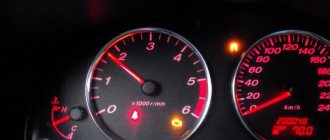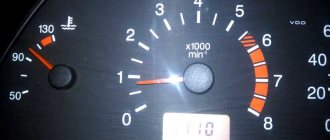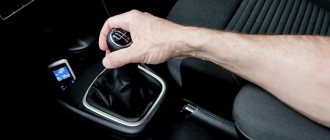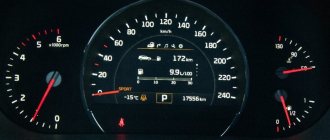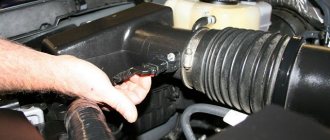In most cars, the crankshaft rotation speed after starting a cold engine is 2-3 times higher than at idle after warming up. This ensures stable operation of the internal combustion engine in this mode and reduces the time it takes to reach operating temperature. Too low speeds when the engine warms up are usually a sign of an imbalance in the air-fuel mixture.
In this article we will tell you what speed should be when starting on a cold one and for what reasons they fall below normal most often.
The origins of unstable engine operation at XX
How will the picture develop if the control unit does not receive data on the quantity and volume of air consumed?
So, for example, the reaction of the throttle sensor will be as follows - the speed will initially increase, but then the fuel mixture will begin to become leaner, as a result of which low speed will be established on a hot engine. There is only one reason for this - the amount of air consumed by the engine has decreased. However, the opposite happens - the fuel mixture becomes richer, and the engine begins to gain speed again. Such cycles can alternate endlessly; these are floating revolutions. The problem of low idle speed on a warm engine in winter is especially pressing.
On some cars, events may develop differently - the speed increases, for example, to 2000 rpm, but remains there. The reason is that the injector injects increased amounts of fuel. The amount of air does not increase, otherwise the engine would be able to increase the speed to 3 thousand, however, then it would still start to stall.
see also
Comments 27
Hello. How did you cure the revs?
maybe the oil is thick?!)
I mean in a box)
I mean in the box) are the gears easily stuck in after frost?
We have above-zero temperatures
then I agree with Putnik64
There was a similar question on 10. at idle 800-900. when coasting downhill, they do not fall below 1500 -1200. I don't think this is a defect. This is the controller's job. it reads information from many sensors, including the speed sensor. the brain simply does not understand how a car can drive at a speed of 80-90 km/h, and at the same time without revs. The controller tries to correct what it considers an error and increases engine speed. equalizing speed and revolutions... when warming up, the engine also maintains increased speeds, regardless of the position of the IAC and TPS. because you take the readings of the temperature sensor IMHO PS, according to the rules, it is prohibited to coast downhill or with the engine turned off. and the controller probably knows about it. ha ha ha
+1 This happens to me too)
There was a similar question on 10. at idle 800-900. when coasting downhill, they do not fall below 1500 -1200. I don't think this is a defect. This is the controller's job. it reads information from many sensors, including the speed sensor. the brain simply does not understand how a car can drive at a speed of 80-90 km/h, and at the same time without revs. The controller tries to correct what it considers an error and increases engine speed. equalizing speed and revolutions... when warming up, the engine also maintains increased speeds, regardless of the position of the IAC and TPS. because you take the readings of the temperature sensor IMHO PS, according to the rules, it is prohibited to coast downhill or with the engine turned off. and the controller probably knows about it. ha ha ha
This is a peculiarity of warranty servicemen - to attribute the malfunction to the design feature of the car. and this is a malfunction that needs to be identified and eliminated!
Well, no offense, I don’t consider this a malfunction. On March 25, 2003, I bought a 10 at the Kursk auto center. A guy came in and asked a question: who has an injector and why are the revs high when coasting? Before that I had a kopek and a tavria. I had no experience with injection engines. Well, there were a lot of people. no one could answer the brow. I’ve been at 10 for 9 years and I’ve been observing this situation for almost a year now at Shnivy. My son has been at Priory for a year. don't turn off the speed downhill. If the engine, God forbid, stalls, you will be left without power steering. and can only be eliminated in this way. PS You asked a question, I shared my personal experience. and so that the servicemen don’t make noodles, learn the materiel!
and I’ve clocked 270k miles on a 10 in just over three years and this has never happened! when coasting, the revs stayed around 1000, maybe a little more, but it’s not 1500-1600 when the engine roars at an intersection. I’ve also been riding a shNiva for almost a year (about 30k) and this has never happened before, so I think that this is still a malfunction that needs to be looked for and fixed!
or change the idle speed sensor
It’s unlikely that the IAC is more likely the TPS. You need to look at the BC, when you completely release the sneaker, the DZ shows 0 or gradually drops to 0.
Is there any way to check this without BC? If you change the TPS, does it also need to be adapted somehow?
Engine speed does not drop: why does this happen?
For normal engine operation and acceptable fuel consumption, it is necessary that all power unit systems operate properly. In this case, the engine should operate normally both under load and in idle mode.
In this article we will talk about why engine speed does not drop, and also consider the main reasons why such problems arise on carburetor and injection cars.
Let's sum it up
As you can see, in order to accurately determine why the engine speed is not reset, in many cases in-depth diagnostics may be necessary. For carburetor engines, cleaning and adjustment of the carburetor itself is often necessary, while the injector will require computer diagnostics.
If the problem is not on the surface (the throttle cable has become sour, after washing or dry cleaning, the carpet in the cabin is not installed correctly, which presses the gas pedal, etc.), then it is better to take the car to a service center.
When releasing the gas, the speed is increased or “freezes”: common malfunctions
Let's start with the fact that on many cars with an injector, the ECU raises the speed while the internal combustion engine is warming up. This is necessary to ensure that the power unit operates stably after a cold start.
However, after the temperature rises, the control unit reduces the idle speed, bringing it to normal. On many cars with a carburetor, the driver independently increases the speed during warm-up, using the so-called “choke”.
Moreover, after the engine is warmed up, the normal idle speed is, on average, 650-950 rpm. If you press the gas and release the accelerator, the speed should increase, and then decrease again to the specified values.
- So, let's start with common carburetor problems. Often the engine speed does not drop due to problems with the throttle valve. For example, when the driver steps on the gas, the throttle must be opened wider to allow more air to enter the cylinders to burn fuel. After the gas pedal is released, the throttle closes and the speed decreases.
If the damper does not close completely, an over-enriched mixture enters the cylinders, and the speed is increased. The cause may be severe contamination of the throttle assembly or damage to the valve itself (deformation). First you need to clean the damper; carburetor cleaning liquid is suitable as a cleaner.
We also note that the damper does not close tightly even when the drive cable is worn out. In this case, the cable must be replaced. On carburetor cars, engine speed often does not drop even if the gasket between the carburetor and the cylinder head has failed. The culprit may also be an intake manifold that is damaged.
The main task is to find the correct ratio of fuel and air. Often, a high level of fuel in the carburetor float chamber also leads to increased speed. The check should begin with the needle valve.
- Now let's move on to the injector. Please note that on many injection cars, after cleaning the throttle valve, the assembly also needs to be additionally “trained”. As for problems, the injection system itself is more complex, that is, there are more reasons for high speeds compared to the carburetor.
In simple words, if the specified sensor gives an incorrect signal, the ECU considers that the engine is cold and activates the warm-up mode. In this case, the control unit raises the speed so that the power unit operates stably and reaches operating temperature faster.
Special attention should be paid to gaskets, since air leaks can lead to disruption of mixture formation. This means that you need to separately inspect manifold gaskets, injector seals, etc.
Problems with the carburetor system
When releasing gas, the drop in speed can be bad for both injectors and carburetor systems.
If the car has a carburetor, then there may be several defects.
Most often, the speed does not drop due to a faulty throttle valve. When the engine warms up, it is in the open position to allow more air into the system. Then it closes and the speed should drop.
If the throttle valve is not closed completely, the mixture will still be over-rich when the operating temperature is reached, and the speed will remain at the same level. If this part is heavily soiled or deformed, it cannot close completely.
You can clean the damper using a special product, which can be purchased at an automotive supply store. Deformation may require replacing the carburetor completely. The damper may not close tightly if the drive cable is severely worn. Replacing it may improve the situation.
Another common reason why the engine speed does not drop when idling is the gasket between the carburetor and the cylinder head, which has become unusable, or a damaged intake manifold.
After replacing the carburetor or cleaning the power system, you can often notice that the engine speed is slowly dropping. This occurs due to improper adjustment of the idle system; an over-enriched air-fuel mixture is often supplied. To eliminate the malfunction, it is necessary to adjust the ratio of fuel and air supply to the system.
A high level of fuel in the carburetor float chamber can also cause a malfunction. The needle valve is responsible for it. Checking this detail may correct the situation.
Floating speed: reasons
Note that in some cases the revolutions do not just slowly fall or remain at the same level, but “float”. In this case, the engine may become unstable. Floating speeds first fall, then increase sharply and everything repeats. A common cause of this phenomenon is the supply of excess air, which leads to “jumps” in speed at idle.
If malfunctions occur, the control unit cannot prepare the “correct” mixture for the idle mode, which causes speed jumps after releasing the gas pedal or when the engine is idling.
How to find the reason and fix it?
Before you can fix the problem, you need to find its source, that is, the part, mechanism or electronic device that causes the speed to triple.
- In a car with carburetors, first you need to check whether the cause of the jumps is a breakdown of the solenoid valve. In this case, the engine will idle only on choke, and if you remove it, the engine will stall. If it breaks, you will have to replace the valve.
- If the reason is not in the valve, then it is necessary to remove the carburetor, thoroughly clean the jets and channels, and replace the carburetor air filter. The jet and channels are cleaned using special aerosols for carburetors.
- You also need to evaluate the fuel level in the float chamber and, if necessary, adjust the flow correctly. Adjusting the carburetor is not the easiest procedure, so if you lack experience, it is better to entrust this work to specialists.
It is more difficult to detect the causes of speed jumps in injection engines, since problems are often caused by the electronic “brains” of the car.
In injection engines, the search for the cause of the breakdown can begin with the idle air regulator (IAC). The condition of the regulator can be checked using a multimeter; if the readings differ from the standard readings of 40–80 ohms, the IAC is broken and will have to be replaced. For minor deviations, you can try to adjust it with a screwdriver, loosening or tightening the screws that control the speed. Diagnostics at a service station can help determine that the mass air flow sensor (MAF) has failed. The reason for contacting may be symptoms of a malfunction (jumps in engine speed) in combination with the Check Engine light coming on. As a rule, modern service stations are equipped with software to determine that it is the mass air flow sensor that has failed. Since the sensor cannot be repaired, it will have to be replaced. You can also check the sensor for malfunction at home: using a multimeter (if the readings are above 1.04, it can be changed) or by turning off the mass air flow sensor. If, with the sensor disconnected, the surges have stopped and the engine speed remains at 1500 RPM, the problem is in the mass air flow sensor. The EGR valve is located in the intake manifold and connects to the exhaust manifold. You can check its operation using a multimeter; you can also carry out a visual inspection of the adjacent tubes and connectors. When replacing the valve, the adjacent tubes must be cleaned of carbon deposits. Testing high-voltage wires can be carried out in several ways. First, you should inspect them for external damage (cracks, cuts). You can also take a closer look at them at night with the headlights off and the engine running. Sparks in the wires indicate breakdowns. The presence of damage can be checked using a wire with stripped ends; one side is applied to the car body, the other must be routed along the explosive wires. An insulation failure can also be detected by the appearance of sparks. Another way to determine insulation failure is to check with a multimeter in ohmmeter mode. Resistance values should not exceed 10 kOhm. In case of any damage, it is necessary to completely replace the high-voltage wires in the set. Checking spark plugs is carried out first visually - a spark plug wet from gasoline or large carbon deposits on it requires immediate action. You can also make sure that the spark plug is working correctly using a special spark plug test gun, which can be purchased at auto stores.
If necessary, the candles are carefully but carefully cleaned of carbon deposits or replaced with new ones. In order to wash the oil crankcase ventilation valve, you need to disassemble the crankcase itself and then remove the valve. The valve is washed to remove oil deposits in kerosene or another chemical.
After drying, the valve can be reinstalled. Flushing the throttle valve from oil deposits can be carried out either with or without removing the unit. Washing is carried out with special chemical aerosols.
The high pressure fuel pump used in diesel cars can be treated with an anti-corrosion agent. To do this, the aerosol is sprayed directly into the neck of the fuel tank before refueling. If you plan to park a diesel car for a long time, then before that you can fill the tank with 200–300 ml of motor oil and drive for 1 day. Naturally, the car will smoke and smoke, but this will prevent corrosion. If the fuel injection pump blades fail, then the entire pump assembly will have to be replaced.
Engine speed does not drop at idle: how to fix the problem
It is very important that the engine operates correctly in any mode, including idling. However, many car owners are faced with a problem: when they release the gas, the engine speed does not drop. As soon as such a defect is discovered, it is necessary to immediately find out the cause and eliminate the malfunction for the smooth operation of the car. Also, the engine may slow down for a long time, which also does not contribute to proper operation.
Typically, upon reaching operating temperature, the speed should drop to its normal level. The manufacturer indicates the indicators for each specific vehicle model in the operating manual. They may vary slightly depending on the mileage and general condition of the car, but usually stay within the range of 650-1000 rpm.
In some cases, the speed drops very slowly or even stays at the same level of 1500-2000 revolutions. In this mode, not only does fuel consumption increase, which affects the driver’s finances, but it also contributes to engine wear.
The cause of the idle failure must be diagnosed by qualified technicians. However, you can also understand on your own why the engine speed does not drop.
When changing gear the revolutions are not reset.
When changing gear the revolutions are not reset.
Post by alik1 » 07 Jun 2012, 19:33
Re: When changing gear for 3 seconds the rpms do not reset.
Post by SanyaXocTa » 07 Jun 2012, 19:53
Re: When changing gear for 3 seconds the rpms do not reset.
Post by alik1 » Jun 08, 2012, 12:47 pm
Re: When changing gear for 3 seconds the rpms do not reset.
Post by KDG-80 » 27 Nov 2013, 11:21
Re: When changing gear for 3 seconds the rpms do not reset.
Post by Sanya66 » November 27, 2013, 11:31 am
Re: When changing gear for 3 seconds the rpms do not reset.
Post by alex4513 » Nov 27, 2013, 12:44 pm
Re: When changing gear for 3 seconds the rpms do not reset.
Post by KDG-80 » 27 Nov 2013, 17:49
Re: When changing gear for 3 seconds the rpms do not reset.
Message KDG-80 » 03 Dec 2013, 13:44
Re: RPM does not drop when changing gear.
Post by Belina » 09 Aug 2016, 18:43
Re: RPM does not drop when changing gear.
Post by 67evgen » Dec 01, 2016, 01:00
Injector system
If your car has an injection system, there may be many more reasons for high idle speeds. Here, both mechanical elements and electronic devices responsible for adjusting the idle speed can fail.
The main injector malfunctions include:
- Incorrect operation of the temperature sensor installed in the cooling system. Incorrectly received data from this device causes the electronics to recognize the engine as cold and work to warm it up, thereby maintaining high speeds necessary to reach operating temperature. Overheating can often occur, which leads to more serious damage, including major engine repairs. The same effect is possible if the idle speed control is not operating correctly.
- The throttle control cable may become stuck. The higher the mileage of the car, the higher the risk of encountering a similar problem.
- The electronic XX operation sensor often malfunctions, then the speed will either increase or disappear altogether.
- The spring that brings the throttle valve to its original closed position is not functioning properly, is jumping off, or is being stretched too far.
- Too much air enters the fuel combustion chamber due to poor quality or leaky gaskets. It is necessary to carefully check the seals of the manifold and injectors.
- And the simplest reason is usually the incorrect placement of the mat after a visit to a car wash or dry cleaning of the interior. It is often inaccurately placed under the accelerator pedal, which leads to the appearance of improper engine operation.
If the car is oversaturated with various electronics and all the work is based on the correct functioning of the sensors, one of them may well become a problem. It will supply incorrect data to the computer, and as a result, the speed will not drop. You will most likely not be able to detect the problem on your own.
It is necessary to contact a car service for computer diagnostics. The task is best handled by specialists working at a service center that specializes in repairing a specific brand of car. If the diagnosis is carried out on time, then it is quite possible to get away with simply replacing the sensor.
You shouldn’t delay repairs, because a supersaturated mixture has a bad effect on engine performance and significantly shortens its service life.
Electronics
The most common cause of unstable speed is a violation in the engine management system. Therefore, the first thing to do is to conduct computer diagnostics. In most cases, this can identify errors in specific sensors and check their operation. Below we look at the most common causes of the problem.
Check the throttle position sensor. Sometimes it may give incorrect signals, causing the RPM to increase. To check, you will have to remove the sensor from the car. It is also recommended to check the condition of the damper itself. Possibly due to contamination
I don't close it completely. If a malfunction is detected, the sensor should be replaced. Just don't buy a cheap Chinese part; most likely, you'll need to buy it again soon. It's better to buy a normal sensor right away.
{banner_content}Damage to the engine control unit bus. Sometimes the wires
, which send a signal to the on-board computer, may be damaged. This happens when the repair is unsuccessful, when a car enthusiast accidentally breaks them. A breakdown can also occur due to a large amount of dirt accumulated on the tire. Be sure to check the functionality of these wires. The easiest way to do this is to install a known working tire. If this cannot be arranged, then you can ring them with a tester in resistance measurement mode. The problem may also be caused by the idle air control valve. Diagnosis of this part is complicated by the lack of response to a malfunction of the engine control unit. Therefore, you will have to remove it in any case. It is essentially a small electric motor that drives a needle that regulates power to the motor. After removal, measure the resistance at the opposite terminals. The device should show 40-80 Ohms
. When measuring resistance at adjacent terminals, the indicator should tend to infinity. If this is not the case, then the regulator is faulty and requires replacement. It must be said that an increase in speed when it fails is rarely observed; usually there are options with a missing idle speed.
If your car has a mass air flow sensor, then this is probably the cause. It rarely fails, but when it breaks down, in most cases it supplies the cylinders with a mixture that is too rich. An indirect sign is the presence of engine detonation. This sensor is quite expensive, and if the TPS can be bought and checked by simply replacing it, then it is better to carry out a thorough diagnosis. The first thing to do is try to disconnect the sensor from power. In this case, the control unit begins to work, starting from the throttle position. If the sensor is faulty, then the motor operation returns to normal. Some sensor models can be checked using a multimeter. To do this, remove the mass air flow sensor, connect it to power, and measure the voltage at the terminals. It should match the recommended one for your sensor. For example, on the Bosch DMRC the permissible voltage is 1.01-1.03 V
. The figure may vary on other models.
